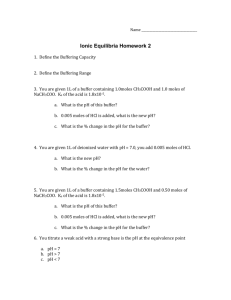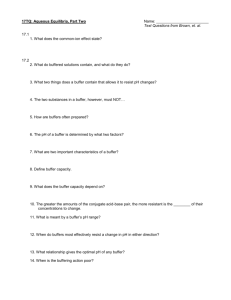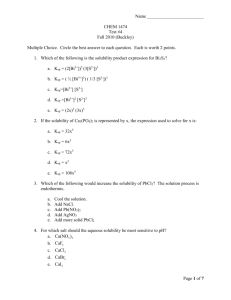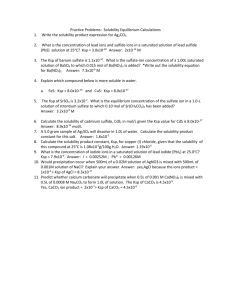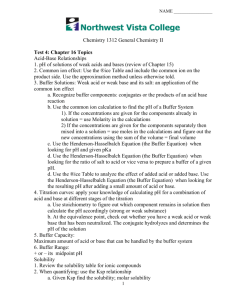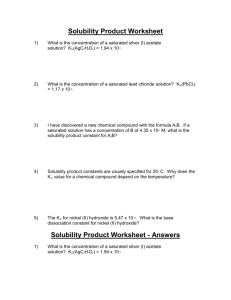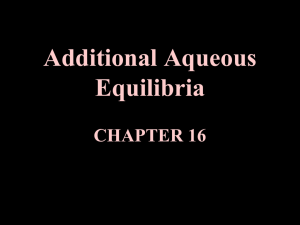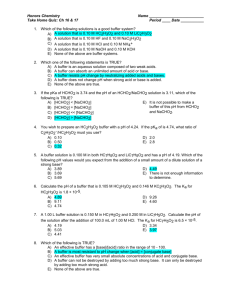Practice Exam 2
advertisement
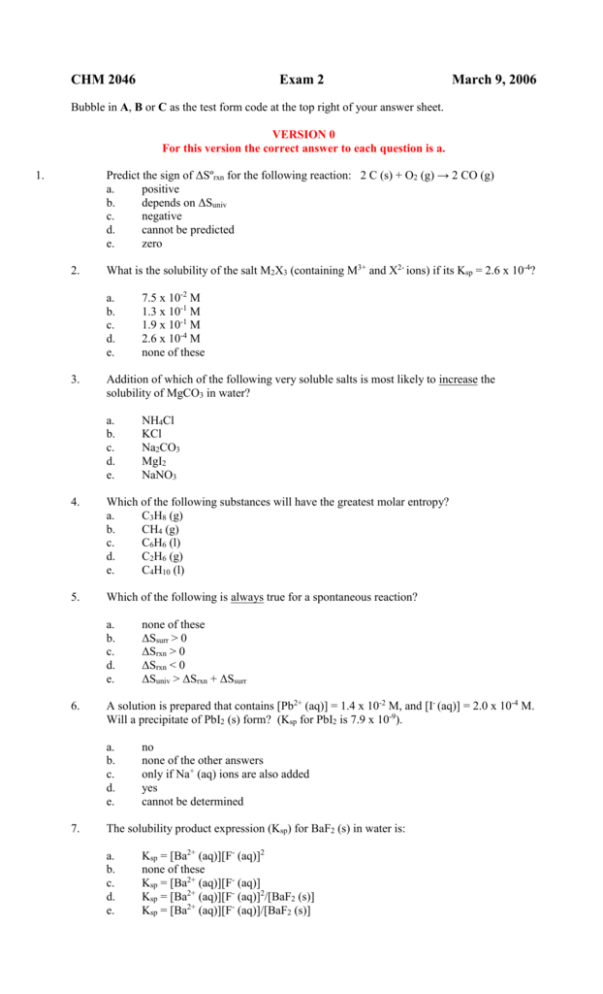
CHM 2046 Exam 2 March 9, 2006 Bubble in A, B or C as the test form code at the top right of your answer sheet. VERSION 0 For this version the correct answer to each question is a. Predict the sign of ΔSºrxn for the following reaction: 2 C (s) + O2 (g) → 2 CO (g) a. positive b. depends on ΔSuniv c. negative d. cannot be predicted e. zero 1. 2. What is the solubility of the salt M2X3 (containing M3+ and X2- ions) if its Ksp = 2.6 x 10-4? a. b. c. d. e. 3. 7.5 x 10-2 M 1.3 x 10-1 M 1.9 x 10-1 M 2.6 x 10-4 M none of these Addition of which of the following very soluble salts is most likely to increase the solubility of MgCO3 in water? a. b. c. d. e. NH4Cl KCl Na2CO3 MgI2 NaNO3 4. Which of the following substances will have the greatest molar entropy? a. C3H8 (g) b. CH4 (g) c. C6H6 (l) d. C2H6 (g) e. C4H10 (l) 5. Which of the following is always true for a spontaneous reaction? a. b. c. d. e. 6. A solution is prepared that contains [Pb2+ (aq)] = 1.4 x 10-2 M, and [I- (aq)] = 2.0 x 10-4 M. Will a precipitate of PbI2 (s) form? (Ksp for PbI2 is 7.9 x 10-9). a. b. c. d. e. 7. none of these ΔSsurr > 0 ΔSrxn > 0 ΔSrxn < 0 ΔSuniv > ΔSrxn + ΔSsurr no none of the other answers only if Na+ (aq) ions are also added yes cannot be determined The solubility product expression (Ksp) for BaF2 (s) in water is: a. b. c. d. e. Ksp = [Ba2+ (aq)][F- (aq)]2 none of these Ksp = [Ba2+ (aq)][F- (aq)] Ksp = [Ba2+ (aq)][F- (aq)]2/[BaF2 (s)] Ksp = [Ba2+ (aq)][F- (aq)]/[BaF2 (s)] 8. Calculate the pH when 100 mL of 0.100 M Ca(OH)2 solution is added to 200 mL of 0.200 M HCl solution. a. b. c. d. e. 9. The following reaction has ΔSºrxn = 197.9 J/K and ΔHºrxn = 49.7 kJ. Is the reaction spontaneous as written? A (g) + B (g) → products a. b. c. d. e. 10. AlCl3 (s) dissolving in water a solid warming from 10 ºC to 20 ºC a tennis ball falling ice at 0 ºC melting to water at 0 ºC none of these Calculate ΔSº for the reaction: H2 (g) + Cl2 (g) → 2 HCl (g) Sº values (J/mol.K): H2 (g) = 130.6; Cl2 (g) = 223.0; HCl (g) = 186.8 a. b. c. d. e. 14. 1.5 x 10-4 M 1.5 x 10-5 M 7.2 x 10-3 M 7.2 x 10-4 M none of these For which of the following changes is ΔSºsys negative? a. b. c. d. e. 13. Na2CO3 KCl NaNO3 KI NH4Cl What is the solubility of BaF2 (s) in a 0.10 M solution of NaF? (Ksp of BaF2 (s) = 1.5 x 10-6). a. b. c. d. e. 12. cannot be determined without the temperature yes no only if ΔSuniv < 0 only if ΔSuniv = 0 Addition of which of the following salts is most likely to decrease the solubility of MgCO3 in water? a. b. c. d. e. 11. 1.18 7.00 1.00 0.88 none of these 20.0 J/K -84 J/K none of these 154 J/K -166.8 J/K At the equivalence point of the titration of a 0.15 M NH3 solution with 0.15 M HCl solution, the pH will be: a. b. c. d. e. less than 7.00 7.00 greater than 7.00 cannot be determined none of these 15. Predict the sign of ΔSºrxn for the following reaction: H2 (g) + 2 O3 (g) → 2 O2 (g) + H2O2 (l) a. negative b. positive c. zero d. cannot be predicted e. depends on ΔHºrxn 16. Which of the following acids is best suited for preparing a buffer solution with pH = 5.00 and a high buffer capacity: C6H5COOH, HNO2, HClO, CH3CH2COOH? a. CH3CH2COOH b. C6H5COOH c. cannot be determined d. HClO e. HNO2 17. Calculate ΔSº for the reaction between NO2 (g) and H2 (g) to give one mole of N2 (g) and the correct number of moles of H2O (g). Sº values (J/mol.K): NO2 (g) = 240.0, H2 (g) = 130.7, N2 (g) = 191.6, H2O (g) = 188.8. a. -56 J/K b. +9.7 J/K c. -9.7 J/K d. -28.6 J/K e. none of these 18. What is the pH of a 0.40 M solution of sodium acetate (Na+CH3COO-)? a. 9.18 b. 4.82 c. 7.88 d. 11.23 e. none of these 19. A particular reaction is non-spontaneous, and has ΔSºrxn > 0. Which of the following statements must be true? a. ΔHºrxn > 0 b. ΔHºrxn < 0 c. ΔSºsurr > 0 d. ΔSºuniv > 0 e. none of these 20. Which of the following salts is most soluble in water at 20 ºC? CaSO4 (Ksp = 2.4 x 10-5); BaSO4 (Ksp = 1.1 x 10-10); PbSO4 (1.6 x 10-8). a. CaSO4 b. PbSO4 c. cannot be determined d. they are all equally soluble e. BaSO4 21. What is the pH of a solution that is 0.050 M in NH3 (aq) and 0.060 M in NH4+ (aq)? a. 9.17 b. none of these c. 9.33 d. 9.43 e. 9.25 22. A buffer solution is prepared containing equal concentrations of CH3COOH (aq) and CH3COO- (aq). What is the pH of this solution? a. none of the other answers b. 4.98 c. 1.30 d. 2.00 e. 3.70 23. Which of the following substances will have the greatest molar entropy? a. C2H5OH (g) b. CH4 (g) c. CH3COOH (l) d. CH3OH (l) e. CH3CHO (g) 24. Consider two buffer solutions A and B: A contains 0.25 M NH3(aq) and 0.25 M NH4+(aq). B contains 0.34 M NH3(aq) and 0.34 M NH4+(aq). Which of the following statements is true? a. b. c. d. e. The pH of both solutions is the same, but buffer B has a higher buffer capacity than A. Buffer A has a lower pH and lower buffer capacity than B. Buffer A has a lower pH and higher buffer capacity than B. The pH of both solutions is the same, but buffer A has a higher buffer capacity than B. Buffer A has a higher pH and a higher buffer capacity than B. 25. Calculate ΔSº for the reaction: 2 N2O5 (g) → 4 NO2 (g) + O2 (g) Sº values (J/mol.K): N2O5 (g) = 346, NO2 (g) = 239.9, O2 (g) = 205.0 a. 473 J/K b. -246 J/K c. 819 J/K d. 299 J/K e. 99 J/K 26. Which of the following salts will give an acidic solution when dissolved in water? a. FeBr3 b. NaF c. K2CO3 d. CaBr2 e. none of these 27. Which of the following will increase the solubility of AgBr (s)? a. addition of NH3 (aq) b. addition of HBr c. addition of AgNO3 (s) (a very soluble salt) d. addition of NaNO3 (a very soluble salt) e. none of these 28. Which of the following salts will give a basic solution when dissolved in water? a. none of these b. NH4Br c. NaI d. KNO3 e. KClO4 29. What is the final pH after 10.0 mL of 0.200 M NaOH are added to a 50.0 mL solution of 0.400 M CH3COOH? a. 3.78 b. 4.12 c. 4.42 d. 2.49 e. 4.87 30. Calculate the Ksp at 25 ºC of a salt MX2 whose solubility is 3.2 x 10-4 M. a. 1.3 x 10-10 b. 3.3 x 10-11 c. 6.5 x 10-11 d. 2.1 x 10-7 e. none of these Useful Information: Acid Ka values Equations -----------------------------------------------------------------------------------------------------------------HIO3 1.6 x 10-1 pH = -log[H3O+] -2 HClO2 1.12 x 10 KW = [H3O+][OH-] = 1.0 x 10-14 (at 25oC) HNO2 7.1 x 10-4 HF 6.8 x 10-4 pH = pKa + log([base]/[acid]) -4 HCOOH 1.8 x 10 C6H5COOH 6.3 x 10-5 CH3COOH 1.8 x 10-5 CH3CH2COOH 1.3 x 10-5 HClO 2.9 x 10-8 HBrO 2.3 x 10-9 HCN 6.2 x 10-10 HIO 2.3 x 10-11 Kb Values -------------------------------NH3 1.76 x 10-3
